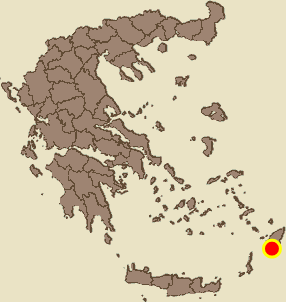Kattavia, Rhodes, Dodecanese,South Aegean
Castle of Kattavia
| Location: |
| Inside the village Kattavia of south Rhodes, 30m south of the central square. |
| Region > Prefecture: |  |
| South Aegean Dodecanese | |
| Municipality > Town: | |
| City of Rhodes • Kattavia | |
| Altitude: | |
|
Elevation ≈ 55 m (Relative Height≈0 m) |
| Time of Construction | Origin | |
| 15th century | IOANNITE |
|
| Castle Type | Condition | |
| Castle Ruins |
In Ruins
|
Ruins of a rectangular late-medieval castle or fortified settlement inside the village of Kattavia in the south of Rhodes, built by the Knights of St John (Hospitaller Knights).
Castle Description
Text: Dr. Michael Losse – Singen (Hohentwiel), Germany (03.07.2021)
General Description
Kattaviá, the southernmost village on Rhódos, is located in a plain surrounded by mountains and hills in a fertile region that was heavily populated during the Byzantine period, as evidenced by several churches. Comparatively large is the number of fortifications around Kattaviá mentioned in the literature, but many of the researchers did not perceive the ruins of the Kástro within the village. Giuseppe Gerola (1914) listed, in addition to the castle in Kattaviá and the nearby Piliókastro ("Paleókastro") “resti di fortificazioni medioevali” on the hill called Stavrós, several watchtowers ("Dhermatàs", meaning Jermatá; "Mávru" meaning Mávros Kávos) and the tower on Prasonísi. In the meantime, we (Ilga Koch and me) were able to locate the remains of other fortifications near Kattaviá during our surveys.
From the castle south of the main square of Kattaviá, only up to 2 m above today's ground level towering, partly over built-up sections of the enceinte remained. Presumably, the large, rectangular Kástro was almost completely removed for the extraction of stones for house construction during the last centuries.
On a drawing by the Swedish Johannes Hedenborg made in 1854, a high round tower can be seen at the castle, probably the commander's seat (cf. Apolona castle). The tower also saw the German traveller and artist Albert Berg (1862, p. 159), at the “entrance of the village”.
As mentioned before, the castle ruins are about 30 m south of the Plateía, disturbed by the reinforced concrete skeleton of an unfinished house and other fixtures (parking areas, company premises, farms). The enceinte consists of various stone formats, in some places there are field-side parts of the enceinte in opus spicatum technique.
Near the castle, at the playground and at the medical center, are lying some fragments of ancient buildings and oil-presses.
Access
No access, private properties, but to be overlooked from different streets around the castle’s enceinte.
History of the castle
It is said that the castle of Kattaviá already existed before the time of the rule of the Order of the Knights Hospitallers (cf. Stephen C. Spiteri: Fortresses of the Knights. Ħamrun, Malta, 2001, p. 150), but it seems to be a confusion with another medieval fortification nearby. It was assumed that the Piliókastro with its fortified settlement in front of it was the older castle of Kattaviá.
For 1408, the existence of a fortified settlement is handed down, into which inhabitants of the village and the region could flee in the event of an attack. Kattaviá Castle was no longer safe and in need of repair in 1471. A remedy was to be created and a new garrison was to be set up. By 1474, the repair had been completed and a moat had been dug around the castle.
Further reinforcements were initiated by the Orders‘ Grandmaster Pierre d'Aubusson (ruled from 1476 to 1503) during an inspection of the fortifications on Rhódos.
According to the Orders‘ chronicler Giacomo Bosio (1594), Kattaviá was to be reattached to “alla moderna” and become as strong as Líndos castle and the Kástro Féraklos (Bosio II, pp. 321, 347, 371.).
In 1914 Gerola still saw the coats of arms of the Order and of Pierre d'Aubusson dated 1481 at the local police station.
Several times during the last third of the 15th century, the Kástro served as a place of refuge for civilians, in 1474 for residents and the garrison of the castellania (the castle district) Mesanagrós, and in 1480, when the Turkish siege of the city of Rhódos was imminent, for the population of some places in the south of the island. But in 1479, when a Turkish attack on Rhódos threatened, the population of Kattavia should seek shelter in the city of Rhódos, according to Bosio (1594).
In 1503 there was a corsair raid on Kattavia, but it is not known to what extent the damage to the place affected the castle.
Large parts of the Kástro were pulled down during the last centuries to re-use the stones for house construction. Even most of the local people are not aware of its still existing ruins.
Other Info
SourcesGerola, Giuseppe: I monumenti medioevali delle 13 Sporadi. In: Annuario Scuola Arch. Atene I, 1914, pp. 319-356.
Losse, Michael: Die Burgen und Festungen des Johanniter-Ritterordens auf Rhódos und in der Ägäis (Griechenland) 1307-1522. (Publisher: Nünnerich-Asmus Verlag) Mainz 2017.
ΣΤΕΦΑΝΙΔΟΥ, Αλεξάνδρα Στ.: Η Μεσαιωνική Ρόδος. Με βάση το χειρόγραφο και την εικονογράφηση του Johannes Hedenborg (1854). / The Medieval Rhodes. Based on the Manuscript and Illustrations of Johannes Hedenborg (1854). O.O.2004.
| First entry in Kastrologos: | July 2021 |
Sources
- Photos (January 2008) and article by Dr. Michael Losse
|
|
| Access |
|---|
| Entrance: |
| No access; private properties, but to be overlooked from different streets around the castle’s enceinte. |



